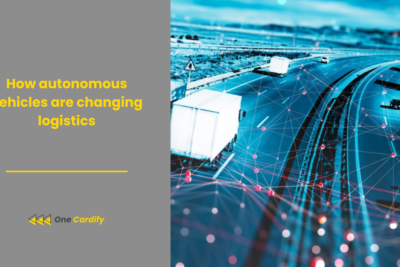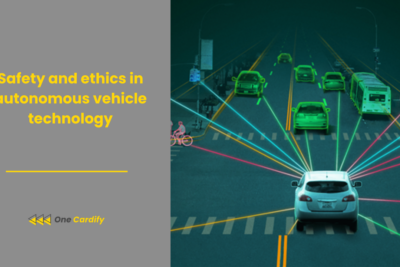
Artificial intelligence in autonomous vehicles
The adoption of artificial intelligence (AI) in autonomous automobiles is a remarkable step in transportation technology. This combination moves us not just closer to entirely autonomous travel, but to safety, efficiency, and user experience as well. While we will be going through this interesting theme, we will dwell on how AI enables such developments and their possible influence on the future of our mobility.AI in the functioning of autonomous vehicles goes far beyond moving through point A to point B, rather, it is a Nobel-prize-worthy kind of system, or even systems, considering the complexity of decision-making, real-time environmental perception, and adaptive learning capabilities. Through these AI systems, vehicles are able to perceive and behave in a flexible and subtle way towards their surroundings.The evolution of AI in autonomous vehicles is not only a preview of what the transportation in the future will look like, but it is changing today the way we view mobility. The capabilities of AI-enriched autonomous vehicles are innumerable from enhanced security to environmental benefits. Now we shall investigate both wonders and difficulties of this ground-breaking technology.
Understanding the Role of AI in Autonomous Driving
Sophisticated artificial intelligence systems are at the core of the autonomous vehicles. Each of these AI systems is developed to interpret sensor data that is collected from the vehicle’s environment, such as other vehicles, pedestrians, road conditions, and traffic lights, in order to take logical actions in real-time.Through the use of machine learning algorithms, these vehicles continually learn from huge amounts of data and enhance their decision-making skills and adapt to new environments. This is important for safe and reliable operation of autonomous driving in different situations.In addition, AI provides predictive maintenance, which predicts the requirements and potential problems with the vehicle ahead of time. Such proactive attitude guarantees a higher level of safety and increases the life of the vehicle.The AI and onboard sensors cooperation ensures a smooth driving performance, competent task handling and passenger safety.
Related content
Related content
The Impact of AI on Transportation
The AI-driven autonomous vehicles as such creates a revolution in the way we commute by providing unmatched convenience and also shaping the urban landscapes. Among these impacts, traffic jams are one of the most profound. By the way of the optimal route planning and coordinated vehicle movement, traffic congestion may be reduced significantly.Additionally, these developments will help to cut down carbon emissions through the optimization of driving patterns and decreasing the number of vehicles on the road. Particularly for the electric autonomous vehicles, this represents a giant step towards sustainable urban planning and environment preservation.Another transformative feature is the improvement of mobility for those unable to drive like the old and disabled, hence, inclusivity and independence in the transport.Economically, the introduction of autonomous cars creates fresh opportunities in the transport industry, which could create new employment and change the pattern of car ownership and taxi services.
Challenges and Ethical Considerations
Despite the progress, the use of AI in autonomous vehicles is not void of obstacles. For example, ethical dilemmas related to decision-making in emergency cases significantly ask moral questions, which need well-developed frameworks of AI behaviour.The security and privacy concerns pose a huge threat as the autonomous vehicles gather and process a huge amount of personal and environmental data.Furthermore, the probable threat to the labour market as the drivers in the traditional transportation roles is a subject for the detailed attention and correct management to avoid the negative consequences.Regulatory obstacles are barriers, too, since the laws and infrastructure in place are not designed to support wide use of autonomous vehicles. Policymakers and industry leaders should collaborate in setting standards and norms that guarantee the safety and equity.
FAQ
AI ensures safety through real-time data analysis, predictive maintenance, and continuous learning to navigate and respond to varying road conditions effectively.
Yes, by optimizing routes, facilitating coordinated movement, and potentially reducing the number of vehicles on the road through shared transportation models.
Autonomous vehicles, especially electric ones, can significantly lower carbon emissions by improving driving efficiency and reducing the number of cars needed.
AI-driven vehicles provide a reliable and safe mode of transportation for individuals with disabilities or those who cannot drive, promoting independence and inclusivity.
Key considerations include decision-making in emergencies, ensuring data privacy, and addressing the potential displacement of jobs in the transportation sector.
There may be disruptions, particularly for driving jobs, but new opportunities in tech, maintenance, and other areas are expected to arise.
Comprehensive legal frameworks and standards are necessary to ensure the safe integration of autonomous vehicles into current traffic systems and societal norms.
Looking Ahead: The Future of AI in Transportation
The evolution of AI in the area of autonomous vehicles is gradually taking us into a world, where traveling turns out to be, safe, faster, and reachable. With the improvement of technology, this sector has a huge chance for innovation, thus, giving us a view of the world of mobility in a totally different way.Neverth2eless, as we approach this future, it is crucial to tackle the ethical, regulatory, and social issues brought by these technological advances. This will enable us to guarantee that the development of transportation will be all-inclusive, sustainable, and will be beneficial to all sectors of the society.All in all, the road to self-driving vehicles driven by machine learning is not a matter of transformation in the form of our mobility only but a question of imagining the opportunities of the global society. The path to the market of the future promises to become more interesting with continued innovation, collaboration, and thinking about challenges ahead.
Conclusion
The introduction of AI in autonomous vehicles is not a mere technological wonder; it is a monumental change in our way of transportation. In essence, as we’ve covered, the implications are huge for safety, efficiency, and the social aspect, so we can see the world where travel becomes brighter, also includes, and green.Even though barriers exist, the promises of AI-based autonomous driving open up a new world of entirely new odd solutions. Thus, as we negotiate these changes, the interplay among the technophilia, public policy makers, and the society in general will be crucial to directing this future towards the good ends for mankind.As we watch and add to the evolution of the transportation system, the part that is played by artificial intelligence in opening new territories of potentiality is huge. The adventure has only started, and the destination is nothing but reforming.The intersection of AI and autonomous vehicles is not just a proof of human intelligence – it is a light leading us towards a more united and effective world.






Related Posts